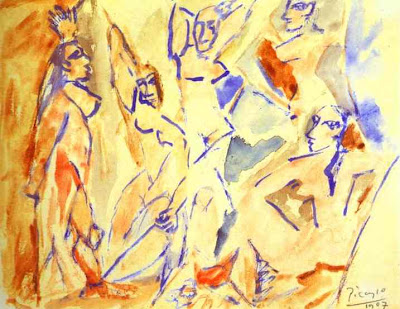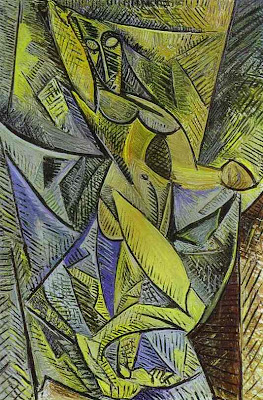 Pablo Picasso was born on October 25, 1881, in Málaga, Spain. The son of an academic painter, José Ruiz Blanco, he began to draw at an early age. In 1895, the family moved to Barcelona, and Picasso studied there at La Lonja, the academy of fine arts. His visit to Horta de Ebro from 1898 to 1899 and his association with the group at the café Els Quatre Gats about 1899 were crucial to his early artistic development. In 1900, Picasso's first exhibition took place in Barcelona, and that fall he went to Paris for the first of several stays during the early years of the century. Picasso settled in Paris in April 1904, and soon his circle of friends included Guillaume Apollinaire, Max Jacob, Gertrude and Leo Stein, as well as two dealers, Ambroise Vollard and Berthe Weill. His style developed from the Blue Period (1901- 04) to the Rose Period (1905) to the pivotal work Les Demoiselles d'Avignon (1907), and the subsequent evolution of Cubism [more] from an Analytic phase (ca. 1908–11), through its Synthetic phase (beginning in 1912–13). Picasso’s collaboration on ballet and theatrical productions began in 1916. Soon thereafter, his work was characterized by neoclassicism and a renewed interest in drawing and figural representation. In the 1920s, the artist and his wife, Olga (whom he had married in 1918), continued to live in Paris, to travel frequently, and to spend their summers at the beach. From 1925 into the 1930s, Picasso was involved to a certain degree with the Surrealists, and from the fall of 1931 he was especially interested in making sculpture. In 1932, with large exhibitions at the Galeries Georges Petit, Paris, and the Kunsthaus Zürich, and the publication of the first volume of Christian Zervos's catalogue raisonné, Picasso's fame increased markedly.
Pablo Picasso was born on October 25, 1881, in Málaga, Spain. The son of an academic painter, José Ruiz Blanco, he began to draw at an early age. In 1895, the family moved to Barcelona, and Picasso studied there at La Lonja, the academy of fine arts. His visit to Horta de Ebro from 1898 to 1899 and his association with the group at the café Els Quatre Gats about 1899 were crucial to his early artistic development. In 1900, Picasso's first exhibition took place in Barcelona, and that fall he went to Paris for the first of several stays during the early years of the century. Picasso settled in Paris in April 1904, and soon his circle of friends included Guillaume Apollinaire, Max Jacob, Gertrude and Leo Stein, as well as two dealers, Ambroise Vollard and Berthe Weill. His style developed from the Blue Period (1901- 04) to the Rose Period (1905) to the pivotal work Les Demoiselles d'Avignon (1907), and the subsequent evolution of Cubism [more] from an Analytic phase (ca. 1908–11), through its Synthetic phase (beginning in 1912–13). Picasso’s collaboration on ballet and theatrical productions began in 1916. Soon thereafter, his work was characterized by neoclassicism and a renewed interest in drawing and figural representation. In the 1920s, the artist and his wife, Olga (whom he had married in 1918), continued to live in Paris, to travel frequently, and to spend their summers at the beach. From 1925 into the 1930s, Picasso was involved to a certain degree with the Surrealists, and from the fall of 1931 he was especially interested in making sculpture. In 1932, with large exhibitions at the Galeries Georges Petit, Paris, and the Kunsthaus Zürich, and the publication of the first volume of Christian Zervos's catalogue raisonné, Picasso's fame increased markedly.
Subscribe to:
Post Comments (Atom)









0 comments
Post a Comment